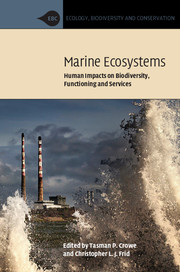Book contents
- Frontmatter
- Contents
- List of contributors
- Part I Key concepts
- Part II Impacts of human activities and pressures
- 6 Marine fisheries and aquaculture
- 7 Artificial physical structures
- 8 Eutrophication and hypoxia: impacts of nutrient and organic enrichment
- 9 Pollution: effects of chemical contaminants and debris
- 10 Invasions by non-indigenous species
- Part III Synthesis and conclusions
- Index
- Plate Section
- References
10 - Invasions by non-indigenous species
from Part II - Impacts of human activities and pressures
Published online by Cambridge University Press: 05 June 2015
- Frontmatter
- Contents
- List of contributors
- Part I Key concepts
- Part II Impacts of human activities and pressures
- 6 Marine fisheries and aquaculture
- 7 Artificial physical structures
- 8 Eutrophication and hypoxia: impacts of nutrient and organic enrichment
- 9 Pollution: effects of chemical contaminants and debris
- 10 Invasions by non-indigenous species
- Part III Synthesis and conclusions
- Index
- Plate Section
- References
Summary
Marine invaders: background
Invasions by marine non-indigenous species (NIS, see Box 10.1 for definitions) have long been recognised. For example, Carl Emil Hansen Ostenfeld described the invasion of the planktonic diatom Biddulphia (Odontella) sinensis Grev. into the North Sea in 1903, probably transported by ships (Ostenfeld, 1908), and over 50 years ago Charles Elton provided the first overview with narrative accounts of impacts associated with high profile marine invasions by oysters and cordgrass (Elton, 1958). However, marine invasions were first approached with a systematic research effort following J. Carlton's seminal work in San Francisco Bay (Carlton, 1979). Today it is recognised that marine NIS comprise a diverse group of organisms found in most marine systems. In a recent review, Hewitt and Campbell (2010) tallied almost 1800 marine NIS and cryptogenic species (Box 10.1) worldwide, dominated by arthropods (444), molluscs (350), fish (166), red algae (153), annelids (104, mainly polychaetes), cnidarians (100), heterokonts (73), bryozoans (73) and green algae (51). Although marine NIS have been introduced around the world, some bioregions are more invaded than others; the most heavily invaded regions are the Mediterranean Sea (467 NIS), Australia and New Zealand (429), the South Pacific (289), the north-east Pacific (284) and the north-east Atlantic (216) (Hewitt and Campbell, 2010). More locally, estuaries centred around metropolitan areas and with extensive shipping traffic are typically the most invaded systems. For example, c. 230, 200 and 100 marine NIS are found in San Francisco Bay, Chesapeake Bay and Port Phillip Bay, respectively (Hewitt et al., 2004; Ruiz et al., 2011). The most important marine vectors are transportation on ships (mainly hull fouling), inside ships (in ballast water, ballast sediments and sea-chests), with aquaculture (in particular associated with oyster transplantations) and via human-mediated removal of physical barriers (e.g. the Suez Canal which connects biota between the Red and the Mediterranean Seas).
- Type
- Chapter
- Information
- Marine EcosystemsHuman Impacts on Biodiversity, Functioning and Services, pp. 274 - 332Publisher: Cambridge University PressPrint publication year: 2015
References
- 6
- Cited by



